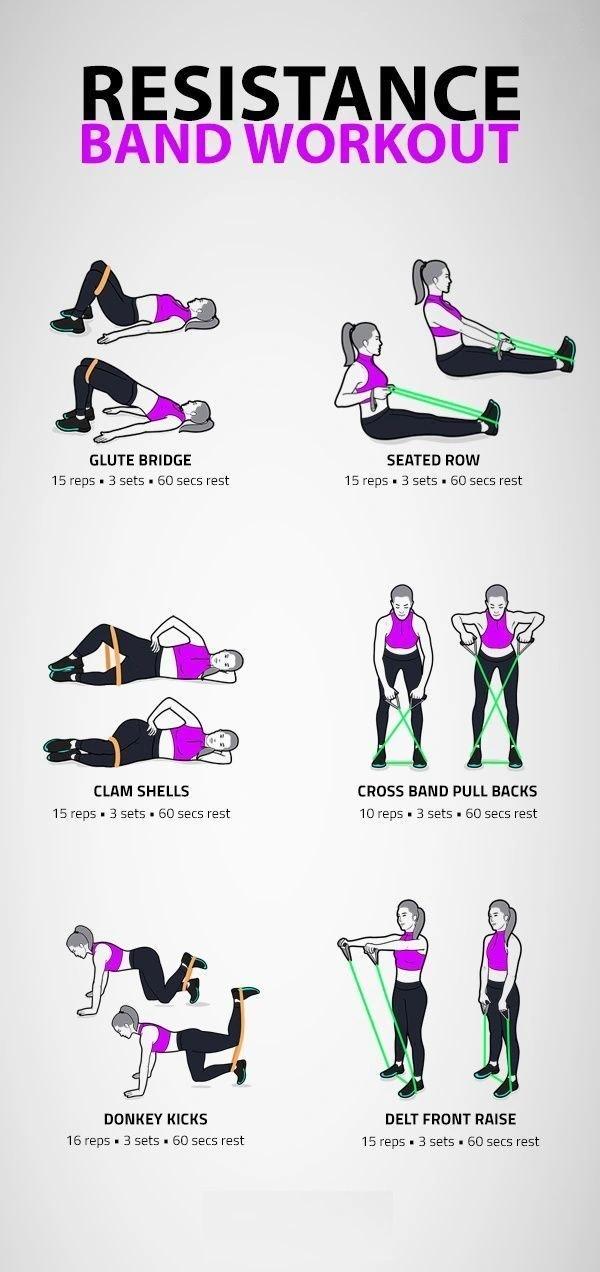How to Use Resistance Bands: Especially for Beginners

Choose the Right Bands:
When it comes to choosing the right resistance bands, it’s essential to consider your fitness level and the specific exercises you plan to perform. Here are some tips to help you select the appropriate resistance bands:
- Resistance bands come in various levels of resistance, usually indicated by different colors. Start with a set that offers a range of resistances, such as light, medium, and heavy. This variety allows you to adjust the intensity of your workouts as you progress.
- Determine your fitness goals and the muscle groups you want to target. If you’re a beginner or focusing on rehabilitation exercises, lighter Resistance Bands are a good starting point. For more advanced or strength-building workouts, heavier bands may be suitable.
- Consider the exercises you plan to perform. Some movements require more resistance than others. For example, larger muscle groups like the legs and back generally require heavier resistance bands, while smaller muscle groups like the arms and shoulders may need lighter resistance.
- It may take some experimentation to find the perfect resistance level for each exercise. Start with a lighter band and gradually progress to heavier ones as you build strength and confidence.
- Invest in high-quality resistance bands made from durable materials. Check customer reviews and opt for bands with reinforced seams or protective sleeves to minimize the risk of snapping or breakage during workouts.
Warm Up:
Warming up before a resistance band workout is crucial to prepare your muscles and joints for the upcoming activity. Here’s a simple warm-up routine incorporating resistance bands:
- Hold the resistance band with both hands, shoulder-width apart. Start by making small circles with your shoulders, gradually increasing the range of motion. Perform 10-15 circles forward and then repeat in the opposite direction.
- Stand with your feet shoulder-width apart and hold the resistance band in front of you with both hands. Keep your arms straight and parallel to the floor. Cross the band in front of your body, alternating which arm is on top. Repeat for 10-15 repetitions.
- Attach one end of the resistance band to a sturdy anchor, such as a pole or door frame. Stand sideways to the anchor, holding the other end of the band with one hand for balance. Swing your outside leg forward and backward, maintaining control and a relaxed motion. Perform 10 swings on each leg.
- Place the resistance band just above your knees. Stand with your feet hip-width apart. Step to the side with one foot, stretching the band and bringing your legs apart. Return to the starting position and repeat on the other side. Perform 10-15 steps on each side.
- Place the resistance band just above your knees. Lie down on your back with your feet flat on the ground and knees bent. Squeeze your glutes and lift your hips off the floor, maintaining tension in the band. Lower your hips back down and repeat for 10-15 repetitions.
Anchor the Band:
Anchoring the resistance band properly is crucial to ensure stability and safety during your workouts. Here are some tips to help you anchor the band effectively:
- Choose a sturdy and secure anchor point to attach your resistance band. This can be a door frame, a vertical post, a heavy piece of furniture, or a specially designed anchor point. Ensure that the anchor point can withstand the force and tension applied to the band.
- If you’re using a door frame as your anchor point, use a door anchor attachment specifically designed for resistance bands. It typically consists of a loop that you can slip the band through and securely attach to the door frame. Make sure the door is closed and locked to prevent any accidents.
- Ensure that the resistance band is securely attached to the anchor point. If using a door anchor, close the door tightly and double-check its stability. If wrapping the band around a post or furniture, make sure it is wrapped securely to prevent slipping or snapping.
- Before starting your workout, give the resistance band a gentle pull to test the anchor’s stability. Make sure it is firmly in place and will not dislodge or move during your exercises.
- Make sure you have enough space around the anchor point to perform the exercises without any obstacles or potential hazards. Ensure that furniture, objects, or walls are positioned away from the band’s path to avoid accidents or entanglement.
- Regularly inspect the resistance band for any signs of wear and tear, such as fraying, cracks, or weakened areas. If you notice any damage, replace the band to prevent accidents or breakage during your workouts.
Proper Form:
Maintaining proper form while using resistance bands is crucial for both effectiveness and safety. Here are some key tips to ensure you have the correct form:
- Stand tall with a neutral spine, engaging your core muscles. Avoid excessive leaning or arching of the back during exercises. Maintain proper posture throughout the movements.
- Hold the resistance band with a firm grip, ensuring it doesn’t slip or snap back unexpectedly. Keep your wrists aligned with your forearms, maintaining a neutral hand position.
- Maintain tension on the band throughout the entire exercise. This ensures that you are working against resistance and engaging the targeted muscles effectively. Avoid slack or excessive stretch in the band.
- Pay attention to the alignment of your joints during exercises. Knees, elbows, and wrists should be in line with each other and not collapsing inward or outward. This helps prevent unnecessary strain or injury.
- Perform the exercises in a slow and controlled manner. Avoid jerky or rapid movements, as they can reduce the effectiveness of the exercise and increase the risk of injury.
- Start with lighter resistance bands and gradually increase the intensity as your strength and form improve. Avoid jumping to heavier bands too quickly, as it can compromise your form and increase the risk of injury.
- Pay attention to any discomfort or pain during exercises. If something doesn’t feel right, stop the exercise and reassess your form. Consult a fitness professional if you have any concerns or questions.
Gradual Progression:
Gradual progression is key when using resistance bands to ensure continued growth, and strength gains, and prevent overexertion or injury. Here are some tips for effectively progressing with resistance bands:
- Begin with a resistance level that allows you to perform the exercises with proper form and without excessive strain. It should provide enough challenge to feel the muscles working but still allow you to complete the prescribed repetitions with control.
- As you become comfortable with a particular resistance level, it’s time to progress. Invest in a set of bands with varying levels of resistance or add attachments like handles to increase the tension. Start with small increments and gradually increase the resistance as you get stronger.
- Increase the number of repetitions or sets you perform as you progress. For example, if you start with 10 reps of an exercise, aim to gradually increase to 12, 15, or more. Similarly, you can add additional sets to your workout routine.
- As you develop strength and stability, incorporate more challenging exercises into your routine. This can include activities that involve multiple muscle groups, advanced variations, or increasing the complexity of movement patterns.
- Slow down the tempo of your repetitions to increase the time under tension for your muscles. This means taking more time during the eccentric (lengthening) and concentric (shortening) phases of each exercise. Slowing down the movement can provide a greater stimulus for muscle growth and strength development.
- Pay attention to how your body responds to the increased resistance and workload. If you experience excessive muscle soreness or fatigue, consider taking a day or two of rest or scaling back the intensity. It’s essential to find the right balance between challenging yourself and allowing for adequate recovery.
Full Range of Motion:
Performing exercises with a full range of motion when using resistance bands is crucial to maximize the benefits and engage the targeted muscles effectively. Here are some key points to consider for achieving a full range of motion:
- Familiarize yourself with the specific exercise and the range of motion it requires. Read the instructions or watch demonstration videos to ensure you have a clear understanding of the movement.
- Set up the resistance band properly and ensure it has enough slack to allow for a full range of motion. Make sure the band is securely anchored and positioned correctly for the exercise you are performing.
- Pay attention to the starting and ending positions of each exercise. Ensure that you are starting from a position where the targeted muscle group is properly stretched and ending in a position where the muscle is fully contracted.
- Maintain control and stability throughout the entire range of motion. Avoid using momentum or jerking motions, as it can limit the effectiveness of the exercise and increase the risk of injury.
- If you find it challenging to achieve a full range of motion initially, start with lighter resistance bands and gradually progress to heavier ones as your strength and flexibility improve. This will help you maintain proper form throughout the entire range of motion.
- If you have limitations in your range of motion due to injury, flexibility issues, or other factors, modify the exercise accordingly. Use a shorter range of motion that feels comfortable and safe for you. As you progress, you can gradually work towards a fuller range.
Breathe and Stay Hydrated:
Proper breathing and staying hydrated are essential elements to consider when using resistance bands for your workouts. Here’s why they are important and some tips to help you incorporate them into your routine:
Breathe:
Proper breathing during resistance band exercises helps provide oxygen to your muscles, enhances performance, and promotes better overall workout efficiency. Here are some tips:
Inhale and Exhale: Breathe in through your nose during the relaxation phase of an exercise, and exhale through your mouth during the exertion phase. For example, when you’re pulling or pushing against the resistance band.
Avoid Holding Your Breath: Some individuals tend to hold their breath when exerting force, but this can lead to increased blood pressure and unnecessary tension. Remember to maintain a steady and rhythmic breathing pattern throughout your exercises.
Stay Hydrated:
Proper breathing and staying hydrated are essential elements to consider when using resistance bands for your workouts. Here’s why they are important and some tips to help you incorporate them into your routine:
Safety Tips for Resistance Band Workouts
1️⃣ Inspect the Bands: Before each use, check your bands for any signs of wear or damage. Replace them if they’re worn out or torn.
2️⃣ Avoid Overstretching: Use bands that provide enough resistance without excessive stretching, as it can lead to breakage and injury.
3️⃣ Start Slowly: If you’re new to resistance training, start with lighter resistance and gradually increase the intensity. Allow your muscles to adapt and prevent overexertion.
4️⃣ Listen to Your Body: Avoid discomfort or pain during exercises. Stop immediately if something doesn’t feel right and consult a professional if needed.
5️⃣ Use Proper Grip: Maintain a firm grip on the bands to prevent them from slipping and causing injury. Avoid excessive tension on your wrists or hands.
4-Week Resistance Band Training Plan
Week 1: Focus on mastering the basic exercises and getting comfortable with the bands.
Week 2: Increase resistance gradually and incorporate compound exercises to target multiple muscle groups.
Week 3: Increase resistance gradually and incorporate compound exercises to target multiple muscle groups.
Week 4: Challenge yourself with more advanced movements and higher resistance levels.

